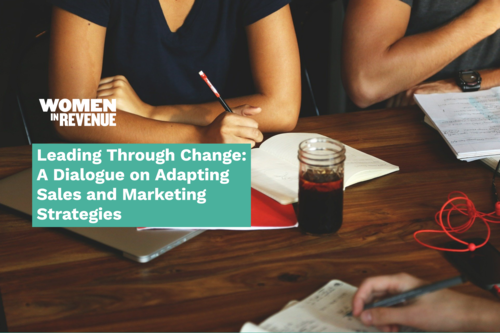By Jen Whalen & Claire Pockell-Wilson
At this point, most of us have probably heard about the adjustments everyone has had to make in order to be more effective in a forced work-from-home setting. Managing calendars and conference calls while quieting barking dogs, making lunch for the kids, or dealing with bandwidth issues are all part of our “new normal.” But these insights into who we are at home play an important role in how we’re shaping business strategies and, in some cases, are fundamentally changing the way we approach sales and marketing.
Last month, Salesforce, a sponsor of Women in Revenue, approached our team with an idea to bring a group of Sales Leaders together for a month-long engagement. During this time, 9 women in Sales and Marketing leadership roles would answer a few surveys and come together for a virtual, guided conversation, moderated by Nina Sommerville, SVP, Commercial Cloud Sales at Salesforce.
The objective was to foster a Leading Through Change dialogue, ensuring we pinpoint key concerns and themes in an effort to truly understand what the new day-to-day is like and how sales teams can begin to recover and grow their business.
Here are 5 key takeaways:
1. Sellers are leading with empathy
More than ever, Sales and Marketing leaders are changing their messaging and tactics to fit for growth companies. They know that many of these organizations are not clear on what the future holds and how they will move forward. Because of this, it is increasingly important for sellers and customer success managers to ask customers and prospects how they can be helpful and add the most value.
2. There’s more focus on a buyer-centric mutual action plan
Instead of moving through the sales cycle as they normally would, sellers are structuring the conversation around their buyer’s pain points, and are recommending and positioning their product(s) accordingly. In most cases, buyers are highly scrutinizing the need for new products or solutions, so sellers must quickly “read the need.” Additionally, changes in the approval process signal the need to sell not only to the end-user, but also 2 desks higher than usual as these stakeholders – the CIO, CFO, etc – play an important role in addressing needs more globally across their sales, marketing, and operations teams.
3. The changing needs of organizations means nothing is certain
It’s obvious that every organization has been impacted by COVID-19. Because of this, many companies are reevaluating their tools and systems to ensure value not only today but for years to come. Customer success managers are asking their clients how they can provide more value, and strategically asking for early renewals to secure funding. Assuming the state of both your customer’s business and your relationship with that customer is healthy, asking for early renewal is a no-brainer. If they agree, you’ll know your product, service, or solution adds incredible value to their business. Cutting through to the ask is also important; spend less time prospecting and/or negotiating and more on asking the right questions to evaluate if the prospect is a serious buyer.
4. Sellers are focusing on the post-signature game plan earlier
For sales teams, the goal is not only around getting a signature on the contract, but rather about driving long-term value. Because of this, sellers should focus heavily on reducing customer attrition by helping current customers get the most value from the tools they already have, plus setting them up for success for any new technology they onboard. This also means approaching and talking with prospects as if they are already a client; ask the hard questions earlier, get the bottom of why they would benefit from your product or service, and present a clear post-signature plan for how you’ll continue to help them grow their business.
5. Getting comfortable with the uncomfortable
As we all begin to find our groove within the current business climate, we should shift our focus away from what we’ve done thus far to adapt and towards what we need to do to thrive. Organizations are ruthlessly prioritizing and pivoting to address the new needs of their clients and, while these shifts are not necessarily comfortable, they will be vital to future growth. As sellers, and as marketers, we can help our customers embrace the unknown by offering partnership and guidance, rooted in a trusted, value-exchange driven relationship.
While these strategies may be somewhat intuitive to most sales leaders, ensuring we’re focused on tracking the way our customers are pivoting and reevaluating their strategies is critical to our own recovery and growth. As time goes on, we’ll find more ways to be in lockstep with our customers in a way that serves both sides of the business agreement. Until then, let’s continue to have these open-ended conversations, share best practices, celebrate the small wins, connect through authenticity, and focus on what works.
If you’re interested in joining our next phase of the “Revenue Community Conversation” with Salesforce, please reach out to Jen Whalen, Director of Product Marketing and Trailblazer Programs at Salesforce.



